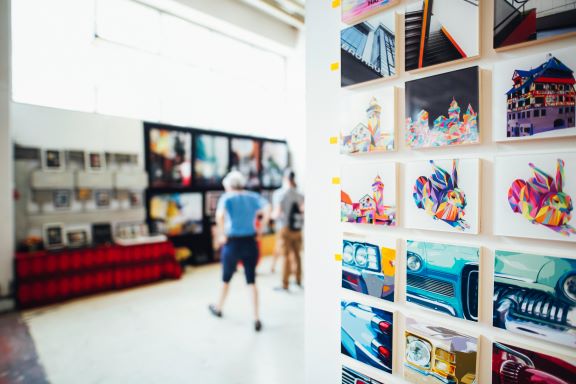Whew! The world and the art business is a very different place from 2019, and that’s great news for artists and the art ecosystem.
Covid-19, NFTs, electric cars, and better tools are some trends that will only make art collecting popularity grow over the coming years.
Wait, what? Electric cars will have an impact on art collecting? Yep. Read on to learn more.
How Do You Define an Art Collector?
Using the most literal translation, someone that owns more than one piece of art qualifies as an art collector, but consider reading our guide to better understand the definition of “art collector.”
If you were to stop someone on the street that might have 20+ plus pieces of original art and ask them to describe their interests, they might not volunteer “art collecting” as readily as their preferred form of exercise or their political party or other categories of interest they may have.
Why Aren’t More People Art Collectors?
There may be many reasons that art collecting has not been as popular as it could be. Some of them include:
- A lack of art community collective effort to build the ecosystem
- How much funding goes into art lobbying globally?
- A lack of really big companies focused on the art world
- Sotheby’s was purchased and removed from the public market for $3.7B US in 2019. Meta, (formerly Facebook), is worth $942B. Possibly 90x larger than Sotheby’s and Christie’s combined
- A single apparel company such as Nike spends more on annual marketing than the entire art ecosystem
- A lack of consumer comfort with putting substantial discretionary funds into art
- Unfamiliar adults are very comfortable spending comparable money on consumables: alcohol, events, travel, clothing, and depreciating assets such as automobiles
How Has Covid-19 Set the Stage for More Art Collectors?
The “new normal” and other overused phrases in large part have to do with societal shifts where thought workers who used to head to offices on a daily basis now work from home. In some cases, their employer mandates they work from home. In other firms, working from home is given as an option and many workers choose to do so.
Firms that allowed work-from-home and now mandate a return to the office are seeing a serious decline in employee satisfaction that is one of the drivers of what is now being referred to as “The Great Resignation.”
The good news for the art world is that serious money is now being invested in home offices, where people are now spending significant portions of their lives. One of the nice things about a home office is you get to decorate it however you choose.
But it’s not just greater independence when it comes to office decor that is driving art collection. Discretionary spending for the global middle class has changed as societies have adjusted in order to slow the spread of Covid-19.
People are not going to nearly as many restaurants, entertainment events, and other high-density locations. One study showed middle-class families showed 5.6% of US middle-class discretionary spending went to eating out.
In automobile-centric countries, a lot less driving is happening. Office workers don’t commute and much less driving related to social activities is happening. Money that in years past would have gone to gas and car maintenance is now available for other uses. Many two-car families have even sold a vehicle.
Electric Cars & Ride Share Will Make Even More Discretionary Spending Possible
For individuals or families that prefer to own a vehicle, they’ll become more likely to be fully electric. While a conventional gas engine has a life expectancy of 100,000-300,000 miles depending on the manufacturer, electric motors are generally referred to as million-mile engines. That said, mechanical repairs for electric vehicles are a lot less common and routine maintenance such as oil and other fluid changes, belt changes, and more are not required at all.
In terms of the cost of operation, electric vehicles charged at home are generally treated as 120 mile/gallon equivalent. That’s 4-6 times more fuel-efficient than the cars many people drive today. That gas expense going away opens up even more discretionary spending.
While electric cars are more affordable to operate, they’ve historically been quite expensive to purchase apart from the low-range Nissan Leaf. You’ll now find electric competition for Tesla from many of the established automakers: Ford, Volvo, Mercedes, etc., which only drive the purchase price down and more availability in the resale market.
Instead of owning electric vehicles, many people will choose to give up owning a vehicle entirely. With the prevalence of Lyft, Uber, and other rideshare companies and more urban living arrangements, owning a car is not a requirement for many.
Money that would have gone to a vehicle becomes available for enhancements to a primary residence such as collecting original art.
NFTS Are Getting a New Population Interested in Art and Keeping Art in the Mainstream News Cycle
NFTs (Non-Fungible Tokens) are getting a lot of press from the same sources that cover cryptocurrency: Bitcoin, Ethereum, Dogecoin, etc. Much of the coverage is because values are rocketing along, and everybody loves a get-rich-quick scheme.
Many would argue the NFT market is going to crash. Can you actually find a buyer for your “unique” jpg when there are 1000s of free copies on the internet?
Nonetheless, among NFT owners and the broader cryptocurrency fan base, there are many millionaires (at least temporarily), and having art top of mind for this population is a very good thing.
With art collecting popularity growing in this group, we’re pretty sure many will realize tangible original art is a lot more enjoyable!
For the wider world of potential art collectors, at present NFTs are getting lots of press in a way that traditional art forms are not, so there’s increased awareness of contemporary artists overall.
Better Tools
Owning an art collection is becoming much easier to manage with apps for art collecting like EtChster’s art collection management software that handles much of the “work” required to maintain an art collection: documentation, location tracking, loan tracking, estate planning, etc.
A Growing Ecosystem
With the tools mentioned above and better tools for artists as well, the art community is starting to act more collectively to grow the global art collector base. Evergreen marketing practices such as setting up a linked email signature, a more collaborative attitude, and an increased focus on digital exposure such as are making it easier and easier for someone to buy their first piece of original art and subsequently start to think of themselves as “an art collector.”
If you’re an ETChster community member, be sure you transfer your Etchings when you make a sale so that the purchaser has a free art collecting app.
What’s Next?
Did you:
- Have follow-up questions?
- Have other related thoughts that might be beneficial to the community?
Post them in the comments!
Are You a Visual Artist?
Get the art catalog app and connected, maintenance-free website your art business deserves. Forever Free & Pro versions.
Are You an Art Collector?
You’ll have access to a marketplace of global artists and phenomenal tools to organize your art collection. Forever Free & Pro versions.
You Might Also Enjoy…

Elevating Your Profile: Harnessing the Power of Reviews for Artists

Amplifying Your Art’s Reach: Harnessing the Power of Physical Backlinks

Mastering the Art Sales Funnel: Transforming Strangers into Buyers


